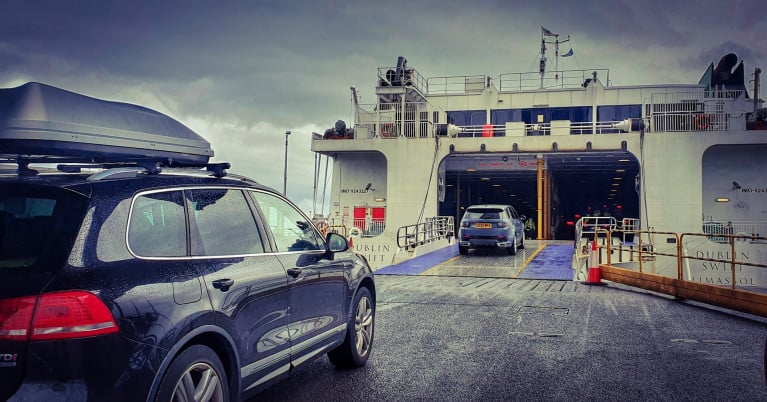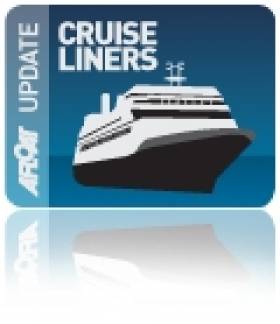Displaying items by tag: Holidaymakers
Irish Ferries High-Speed Craft Returns to Service During Dublin-Holyhead Route's High-Season
Irish Ferries high-speed craft Dublin Swift finally returned to service on the Dublin-Holyhead route with holidaymakers travelling during this summer's key peak-season month, writes Jehan Ashmore.
With the easing of Covid-19 travel restrictions introduced last month, Irish Ferries this week resumed the HSC Dublin Swift service, offering customers an alternative faster option on the Irish Sea's only direct cross-channel fast-ferry service between Ireland and the UK.
Asides the conventional cruiseferry Ulysses and ropax Epsilon, each taking 3 hours 15 minutes to complete, the Dublin Swift's passage time is just 1 hours 49 minutes. This is achieved by the HSC's 35 knot capability when running between the Irish capital and the north Wales port in Anglesey.
Dublin Swift's sailing schedule sees two sailings in each direction daily and with travel restrictions in many countries currently being relaxed, Irish Ferries have introduced additional measures across their fleet to ensure that both passengers and crew can ‘Travel Safe’.
In pre-pandemic times, such fast-ferry operations on the Ireland-Wales link would of begun much earlier, with the season starting in April.
Facilities on Dublin Swift include a Club Class lounge, Brassarie, Cafe, TV lounge, Gaming Zone and Wi-fi connection is available. In addition an on board shop. Noting, that the Irish Ferries website cites that due to the impact of Covid-19, not all advertised ship facilities may be open.
The HSC Dublin Swift, likewise of its predecessor, Jonathan Swift was built by Austal-Ships, Freemantle, Australia in 2001 and can carry 900 passengers, 200 cars and 16 trucks. The twinned hull craft originally entered service for Irish Ferries in 2018 having been acquired as secondhand tonnage.
This year is the first summer season that Irish Ferries can also offer customers an inclusive UK 'land-bridge' service with the opening in June of their new service on the Dover-Calais route. The new UK-France service followed the transfer of cruiseferry Isle of Inishmore from the Rosslare-Pembroke route currently served by the chartered-in Greek flagged ferry Blue Star 1.
In addition, Irish Ferries run direct Ireland-France services on the Dublin-Cherbourg route served by cruiseferry W.B. Yeats. The largest ship of the fleet is supplemented with additional capacity at weekends by Epsilon. This Italian registered ropax was chartered to launch the Ireland-France route in 2014..
The ro-pax ship assists to cater for Brexit related freight market demand on the direct service to continental Europe.
Come Cruising at the Holiday World Shows
The following ferry, cruise and specialist travel companies exhibiting at the Belfast venue are: DFDS Seaways (formerly Norfolkline), Celebrity Cruises, Complete Cruise Solution, Cruise & Maritime Voyages, Cunard, Norwegian Cruise Line, P&O, Princess, Pullmantur Cruises, Regent Seven Seas Cruises, Royal Caribbean Cruise Line, Seabourn, Silverseas Cruises, The Cruise Machine (trading as Vamos Holidays) and Voyages To Antiquity.
On the following weekend, The Holiday World Show in association with The Sunday Times will be held on 28, 29 and 30 January at the RDS Simmonscourt, Dublin, which incorporates the Caravan & Motor Home Show.
Like the Belfast show The World World Show in Dublin will have numerous exhibitors with worldwide destinations and all types of holidays on show. The following ferry, cruise and specialist travel operators will be exhibiting: Azamara Cruises, Celebrity Cruises, Celtic Link Ferries, Cruise & Maritime Voyages, Cruise Holidays, Travel.ie, Hurtigruten, John Galligan Travel, MSC Cruises, Princess Cruise Lines, Pullmantur Cruises, Regent Seven Seas Cruises, Royal Caribbean Cruise Line, Saga, Silversea Cruises, Thomas Cook and Voyages To Antiquity. Also at the show will be Emerald Star for those interested in taking a cabin-cruiser holiday on the Shannon.
Visitors to the Holiday World Show Dublin can attend cruise talks hosted by the Eoghan Corry Free Expert Clinics during the three-day long show. For a full listing of exhibitors, ticket prices, opening hours and further information about both shows logon to www.holidayworldshow.com






























































